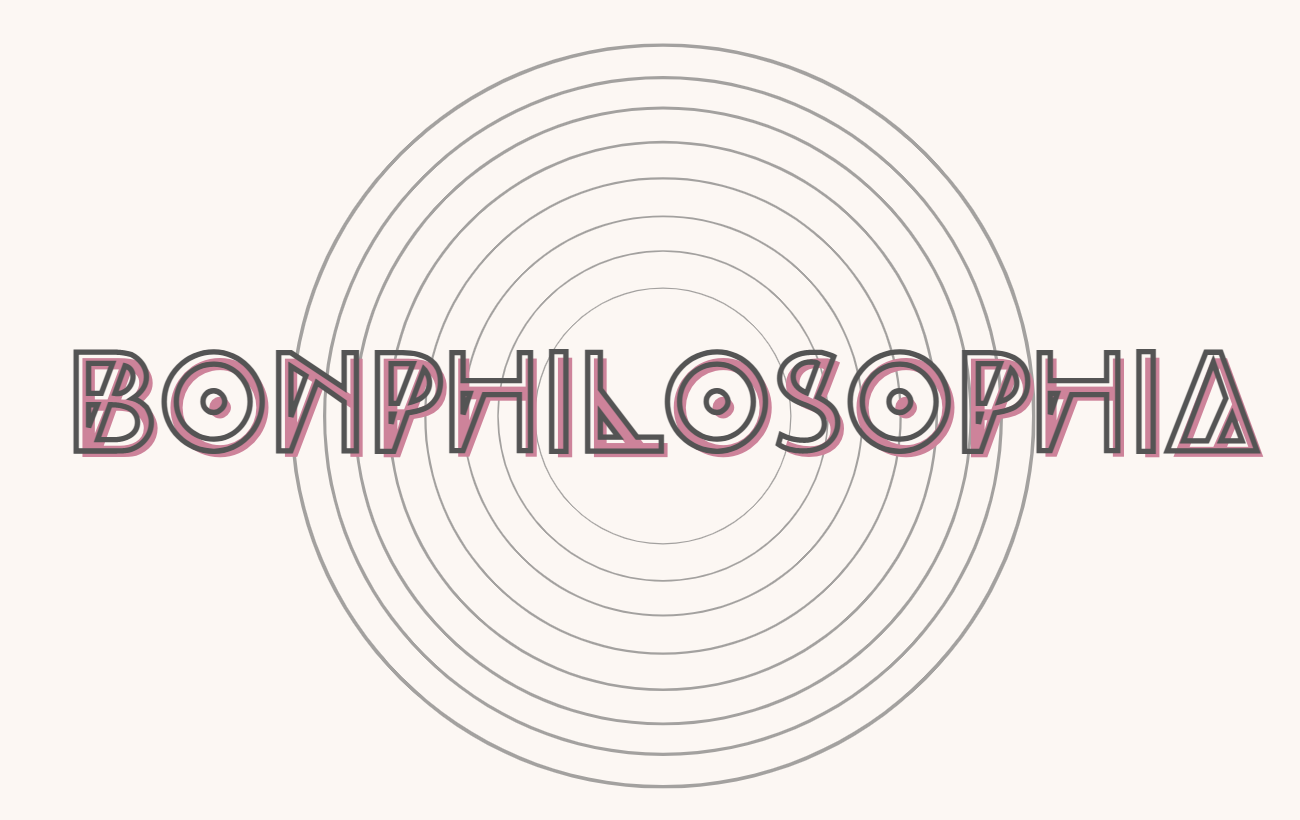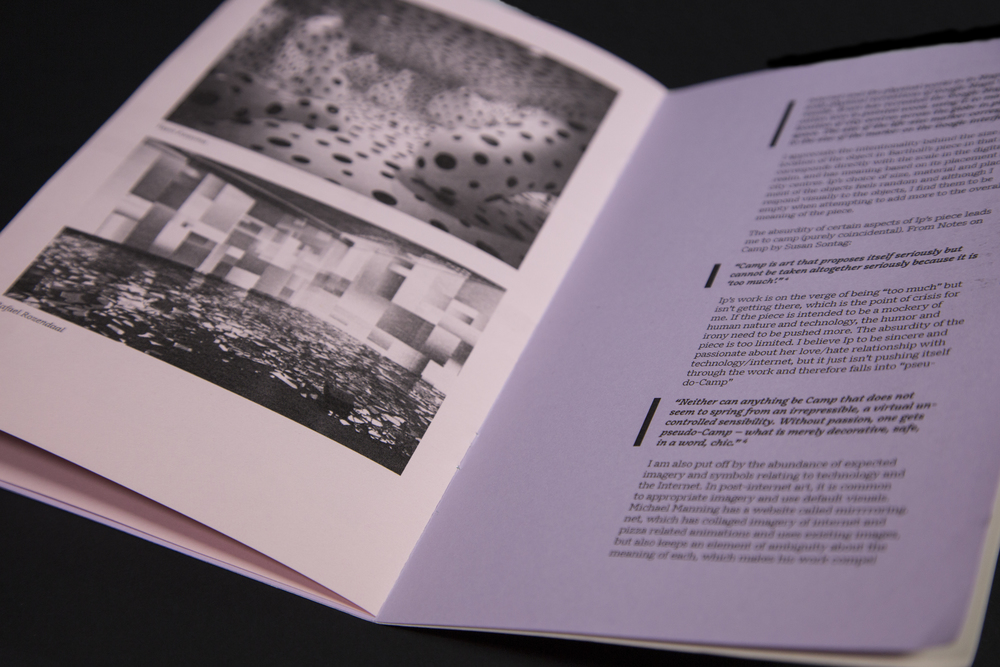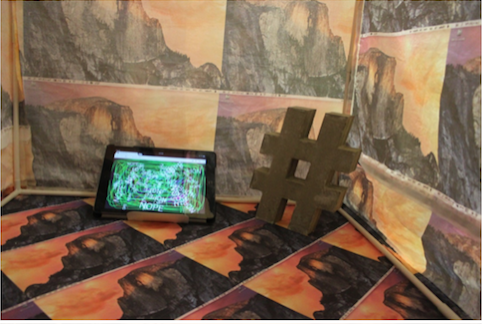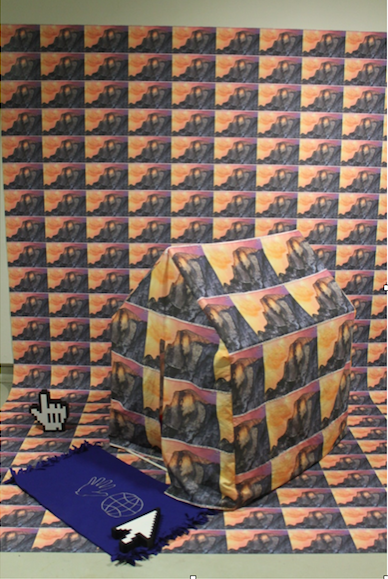KRISTA LANGEHENNIG ON HELEN IP
GUEST CONTRIBUTOR:
Krista Langehennig
Cranbrook Academy of Art
MFA Candidate
Screenshots on screenshots on screenshots! Helen Ip’s piece, titled The New Hypergraphy: Asymptote of the Times includes an obnoxiously tiled pattern of the default background for OS X Yosemite hung on a portion of the crit room wall, draping down to cover a section of the floor. I glance around and see obvious Internet symbols rendered in life-size arbitrarily placed throughout Ip’s “virtual” reality. The purple pink sunset simultaneously hurt my eyes while putting me in a meditative state due to the familiarity of it. I want to scratch my eyes out while simultaneously enjoying the appeal of the child-size Yosemite tent. #dope!! was my initial reaction to Ip’s piece, as I surveyed all the different mediums she experimented with. I felt immense pleasure and excitement about the possibilities of what I was about to experience in Ip’s Internet world made physical.
The threshold of the tent greets me with a blanket/welcome mat embroidered with symbols literally saying “Herro! Welcome to the internet!” I enter the tent feeling like a child thinking of the possibilities I would discover within. I awkwardly climb into this child-size tent and almost squish the still, drippy, life-size beach ball of death in the left corner. The iPad has a browser window with the URL “areyouok.click”. I attempt to click “OK” because I feel pretty OK in the moment. Nothing happens until I draw a line and at the end a “NOPE” tells me I am not ok. I am clearly being mocked by my inability to press the OK button and realize the only power I have is to draw lines. Then this in itself becomes fun, becomes a toy to play with, I spent five minutes drawing “NOPE” lines repeatedly until I realized there was nothing left for me to do in this tent. The beach ball and the hashtag serve as toys I can’t play with even though they exist in my physical world, and I am left feeling overall disappointment with my short-lived experience inside the tent.
I wonder if I have fallen into a strange Internet tent revival and Helen is the technological evangelist spreading the word from California’s tech industry that technology is the new religion. The default Apple image with a completely cleared desktop relinquishes the human touch of personalizing one’s computer. It is pure, untouched, Apple goodness, factory settings and all. The purity of the default image becomes an almost spiritual experience. The oversized cursors/hashtag/spinny beach ball act as idols to worship. As the creator of this piece, Ip falls into the same trap she is mocking. Helen implicates herself as part of this religion by taking the time to create these physical Internet idols. This path feels a little far-fetched though.
The physical production of everyday objects in Ip’s piece reminds me of the artist Jeff Koons.
“A lot of Koons’ works is big; he uses size to defamiliarize everyday objects. In the series Banality, he takes the kind of ornaments you might find in a gift shop and enlarges them out of all proportion. The most famous of these sculptures is Michael Jackson and Bubbles, a grotesquely sentimental trinket that Koons, along with the other items in the series, finds “very beautiful, very seductive…” 1
This is where I find faults in Helen’s piece with the production of the cursors, beach ball and hashtag. Materially, I am interested, but the size indicates the false possibility of interaction. The placement within a small, personal space leaves the viewer expecting more from these static objects. I see Koon’s work as successful because of the visual impact and absurdity of producing these recognizable objects at such a large scale. Ip’s pieces are still small enough to hold, which makes them feel less ridiculous and less impactful in comparison. Ip’s work also brings to mind the artist Aram Bartholl as he “explores the the blurred lines between the internet and the physical world in in Map; 1:1 scale physical recreations of Google Maps’ search results. Aram has recreated the Google Maps location icon in painted wood, using it to mark the location of city centres across the globe in physical space. The size of the life-size marker corresponds to the size of the marker on the Google interface." 2
I appreciate the intentionality behind the size and location of the object in Bartholl’s piece in that it corresponds directly with the scale in the digital realm, and has meaning based on its placement in city centres. Ip’s choice of size, material and placement of the objects feels random and although I respond visually to the objects, I find them to be empty when attempting to add more to the overall meaning of the piece.
The absurdity of certain aspects of Ip’s piece leads me to camp (purely coincidental). From Notes on Camp by Susan Sontag, “Camp is art that proposes itself seriously but cannot be taken altogether seriously because it is “too much.” 3 Ip’s work is on the verge of being “too much” but isn’t getting there, which is the point of crisis for me. If the piece is intended to be a mockery of human nature and technology, the humor and irony need to be pushed more. The absurdity of the piece is too limited. I believe Ip to be sincere and passionate about her love/hate relationship with technology/internet, but it just isn’t pushing itself through the work and therefore falls into “pseudo-Camp.”
“Neither can anything be Camp that does not seem to spring from an irrepressible, a virtual uncontrolled sensibility. Without passion, one gets pseudo-Camp – what is merely decorative, safe, in a word, chic.” 3
I am also put off by the abundance of expected imagery and symbols relating to technology and the Internet. In post-internet art, it is common to appropriate imagery and use default visuals. Michael Manning has a website called mirrrroring.net, which has collaged imagery of internet and pizza related animations and uses existing images, but also keeps an element of ambiguity about the meaning of each, which makes his work compelling. I am craving more ambiguity and depth in Ip’s piece. This leads me to believe the interaction with the iPad is one of the more interesting aspects of the piece.
Ip’s “virtual” physical reality becomes a metaphor for our everyday lives as we isolate ourselves from other humans through technology and waste hours doing the pointless, meaningless surfing of the Internet; equivalent to drawing “NOPE” lines in a tent. Ip’s scene is something that doesn’t literally exist on this earth, but metaphorically represents our daily lives. The physical manifestation is intended to create an experiential aspect, but the piece is overall too static to round out the experience. Like the installations of Yayoi Kusama, and Rafael Rozendaal, I crave an all-encompassing and exciting experience through installation, which feels like something Ip is reaching for, but without complete success. The wallpaper only covers a section of the crit wall and pulls me out of her “virtual” reality - I cannot immerse myself. The sculptures of Internet symbols underwhelm me, and the only thing I can slightly draw from them is the irony of not being able to use these recognizable symbols in the physical realm and not receiving the instant gratification we expect in the digital realm.
I have a positive experience for the few minutes I can spend discovering the piece, but then the abundance of repetitive symbols brings me to a point where I can’t discover new meaning. My experience inside the tent was personal, fleetingly exciting, and then empty. It is exactly the same as my relationship with the Internet, I get to a website, play around for a few minutes and then realize I want to move on to the next thing. Susan Sontag says, “Something is good not because it is achieved, but because another kind of truth about the human situation, another experience of what it is to be human - in short, another valid sensibility - is being revealed.” 3
If Ip is attempting to mock society’s shallow, short attention span style of internet use, I would find the piece to be successful, but the timidness of the piece makes it difficult to fully realize.
The review can also be seen here: http://www.kristaroselang.com/#/review-of-helen-ips-work/
NOTES
1. Emma Brockes, Jeff Koons: People respons to banal things-they don’t accept their own history, http://www.theguardian.com/artanddesign/2015/jul/05/jeff-koons-people-respond-to-banal-things-they-dont-accept-their-own-history.
2. Joanne McNeil, Domenico Quaranta, Nick Lambert, Art and the Internet (London UK: Black Dog Publishing., 2013), 132.
3. Susan Sontag, Notes on ‘Camp', http://interglacial.com/~sburke/pub/prose/Susan_Sontag_-_Notes_on_Camp.html






